Jordan, Lebanon, and Syria (1999)

Europe on $5.00 a Day: True Stories
July 7, 2020
Komodo and Sulawesi: Boogeymen, Big Snails, Bigger Dragons and the Biggest Funerals
December 19, 2020Jordan, Lebanon, and Syria (1999)
By Rich Juro
This journey occurred in the spring of 1999, during a relatively peaceful time for Lebanon, and before the civil war that wracked Syria from 2011 to the present. As Jews, Fran and I were concerned visiting these Arab countries, but not due to revolutions or unrest in those nations.
Jordan
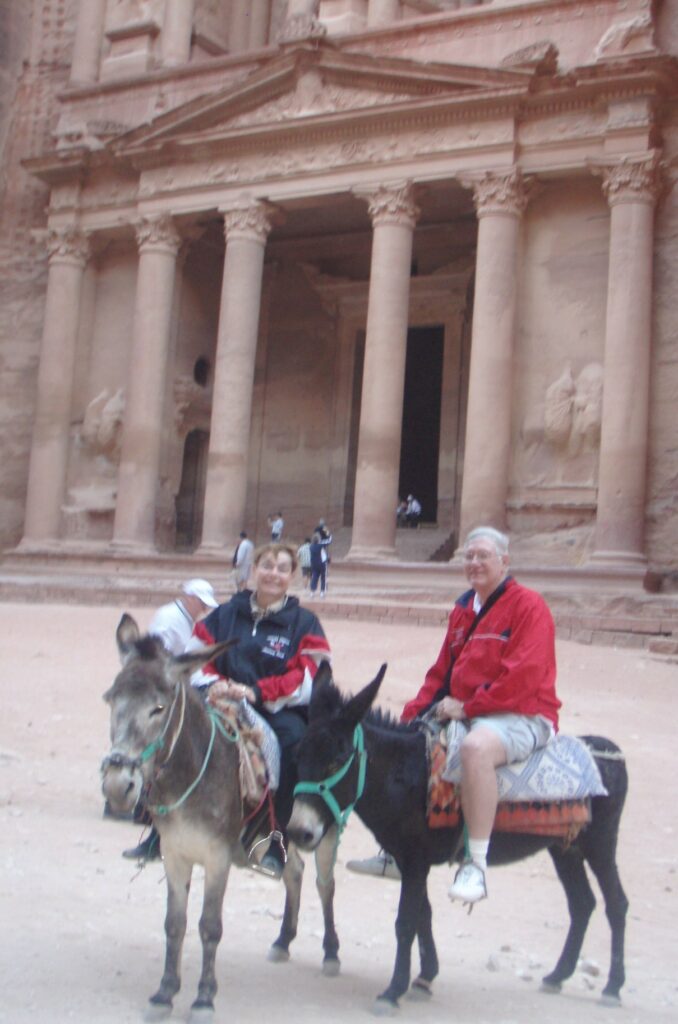
Petra, Jordan
We flew into Amman, the capital of Jordan. The city was founded by Ammonites, of course, in the 13th Century BC. The area we know as Jordan was long ago the Biblical tribal kingdoms of Moab, Edom, and Ammon. Some of us are familiar with the wars that those realms fought with the Hebrew states of Judah and Israel. 1000 years later, the Nabateans ruled the area from 169 BC to 106 AD. Their main lasting contribution was the amazing place called Petra. More on that later.
The Roman Empire took over and renamed Amman as Philadelphia. Later the Ottoman Turks ruled until World War I. After 1918, the British set up a protectorate and called it Transjordan. Britain named the Hashemite tribal chief Abdullah as the nominal emir. When independence came in 1946, the land was officially called the Hashemite Kingdom of Jordan, with Abdullah as king. His son, Hussein, was king from 1953 to 1999, and succeeded by his son, Abdullah II, who has led Jordan for over 20 years. Now Jordan is a constitutional monarchy, although the king still has significant power.
For a landlocked country without much in the way of natural resources, Jordan has done pretty well. It has a well-skilled workforce and a progressive government (by Middle East standards). Along with Egypt, Jordan signed a genuine peace treaty with Israel in 1994. It was relatively untouched by the Arab Spring revolts that upended so many nations in the area. But along with its 10 million citizens, primarily Sunni Muslim, it hosts 2 million Palestinians, and, now, 1 ½ million Syrian and Iraqi refugees. Hence, it needs massive foreign aid, primarily from the USA.
Tourism and medical tourism (mostly Arabs from other countries) are important sources of income. We were there as regular visitors, so we started by seeing the sights in and around Amman. The Citadel is a huge complex in the heights overlooking the city. It has Roman ruins including a still used 5000 seat amphitheater, and the Temple of Hercules. There are also Byzantine and Umayyad ruins. Also in Amman is the Grand Husseini Mosque, erected in honor of the late king.
The next day we drove 3 hours to the world famous archaeological site of Petra. It was built by the Nabatean people over 2000 years ago as a major trading center. Petra was home to 20,000 people, who harvested rainwater and irrigated their agricultural land. Arriving at the outside, we mounted horses to ride through the ¾ mile natural gorge. You can also ride a donkey, or walk, as we did on a subsequent visit. Upon exiting the narrow passageway, we were treated to an unbelievable sight: a big plaza with rose colored buildings carved out of the high rocks. We stayed at a nearby hotel, and were up early the next morning to see the magnificent complex again. We spent the day marveling at the multiple constructions, and clambering up to the “High Places”. Petra is one of those places that must be seen to be believed.
On the way back to Amman, we took a different route. We visited the Dead Sea, the lowest point on earth. Floating on the Dead Sea with its plethora of salts was the same on the Jordan side as it is on the Israeli side. Next stop was a functioning winery, obviously run by Christians. We sampled the wine and it was actually good. Finally, we traveled to Mount Nebo, overlooking the Jordan River. Reputedly, Nebo was the mountain where Moses was given a view of the Promised Land, but he was never to enter. According to Christian texts, Moses was also buried on Mt. Nebo, but both claims are subject to some dispute. Nevertheless, the mountain has been visited by two Popes in recent years.
Lebanon, and Our Group
We flew to Beirut, formerly known as the Paris of the Middle East, and the capital of Lebanon, which is in the past was called the Switzerland of the East. Both Beirut and Lebanon were called those names because of their natural beauty and their thriving commerce. But for 15 tragic years, from 1975 to 1990, Lebanon underwent a horrible civil war that killed thousands of people and destroyed much of the country. We were there in 1999, when the nation was somewhat rebuilt, but before the chaos that followed in recent years.
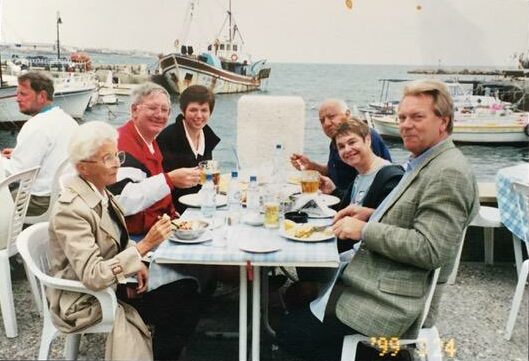
Lebanon-Seaside Meal with Elizabeth, Rich, Lisa, Walt, Fran, and Jan
But first a word about our fellow travelers. There were 8 of us, plus our travel escort, and our local guides. The most memorable was Walter and Lisa Kran. Walt was a retired physician and was very proud of his Armenian heritage. His father was a pastor in the Nazarene Protestant Church (not the Armenian Orthodox Church). The church and parsonage were across the street from the King David Hotel in Jerusalem. In 1948, when Israel was fighting for its independence, the Israelis needed places to live. They threw out Walt’s family from Jerusalem, and the family eventually went to America. It’s no wonder that Walt was vehemently anti-Israel, but not anti-Semitic.
Lisa was Walt’s second wife. She was at least 30 years younger than him, and very attractive. They were a loving couple and fun to be with. We went to a restaurant-nightclub near Beirut with them. Our server was an attractive young woman.
Walt said: “She’s of Armenian descent.”
Lisa, Fran, and I said, “No way.”
So we asked if she was was Armenian, and when she said “Yes”, Walt just beamed and said, “I told you so”.
Armenians settled in Lebanon and Syria 100 years ago when fleeing from the Turkish genocide on them. We learned that almost all Armenian last names end in “ian” or “yan”. Examples are Kirk Kerkorian, the movie mogul, the writers William and Aram Saroyan, and the infamous Kardashians of TV reality fame.
One of the members of our group was an older pleasant lady named Elizabeth. She traveled by herself with just a small carry-on. Elizabeth changed clothes every day, and every evening washed the one outfit she had worn that day. What was amazing was that Elizabeth was going on a three week tour of Iran after our three week tour.
There was a couple from Toronto. The husband. Lionel, was fastidious and a know-it-all, although he was usually correct in his assertions. Somehow I got along with Lionel even though I often made gentle fun of him. At the end of the tour, I wrote a poem about the journey and its members. Lionel, and especially his wife, loved my satiric characterizations of him.
Our tour leader was a Dutchman named Jan. He was tall, very nice, and experienced in world travel. Fran called Jan her “mountain goat” after he helped her navigate the uneven ground of the heights of Petra.
Long ago, from 1100 BC for over a thousand years, the Phoenicians lived primarily in Lebanon. They were great seafarers and merchants, and for centuries they dominated the Mediterranean coast: Greece, Asia Minor, North Africa, and even Spain. Carthage was founded by Phoenicians around 800 BC in present day Tunisia, and was a major power in the western Mediterranean for 600 years. For those of you who are history buffs, when Roman defeated Carthage it was called the Punic Wars. The word Punic is derived from Phoenician.
Later the area we now know as Lebanon was under the rule of the Persians, then the Greeks, Romans, Byzantines, Arabs, Egyptians, and finally the Ottomans from Turkey. After World War I ended in 1918, France and Britain divvied up the losing Ottoman Empire. France decided to form a small new country along the Mediterranean Sea where many Christians lived, and that’s how Lebanon was created.

Lebanon Poster-All Our Disaters Caused by USA
A question for those who consider themselves political governance experts: What is multiconfessionalism? Answer: Multiconfessional countries have a power sharing arrangement between people of different faiths, usually three or more significant religious groups within the same jurisdiction. The only two modern multiconfessional countries are Lebanon and Bosnia-Herzegovina.
After WWII, when Lebanon became independent, the three principal government posts were set up in perpetuity to be held by people of the three principal religions: Sunni Muslim, Shia Muslim, and Maronite Christian. Other significant religious minorities are the Christian Greek Orthodox and the Druze (a distant sect of Islam). Even though the Muslims have a much higher birth rate, and many Christians have emigrated from Lebanon, the three principal positions remain in those same religions. Has it worked? For awhile, small Lebanon was both beautiful and thriving, but from 1975 till today it has faced civil wars, constant unrest, and wars with Israel and Syria. Unfortunately, two government ministers are members of the terrorist group Hezbollah, which has a significant population in southern Lebanon. Still, Lebanon is more democratic than most Middle East countries.
Past and present, Christians lived in the East part of Beirut, and Moslems in the West section. During the civil war, the central city was abandoned due to the constant shelling, and the no-man’s land was called the Green Line. Our guide showed us where it was.
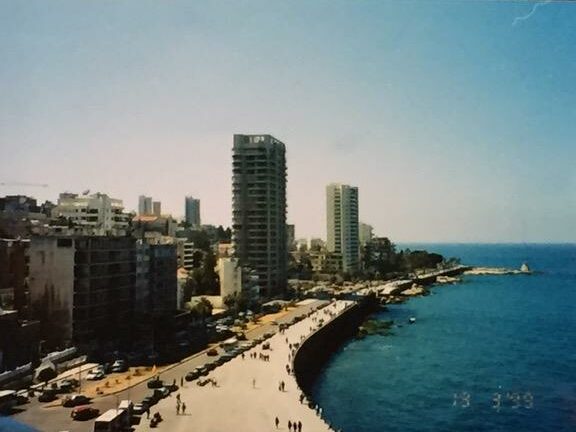
ebanon-Beirut with Corniche (Seasside Boulevard)
We were there to see the sights of Lebanon. Beirut was also called the Pearl of the Middle East because of its beauty and charm before the civil wars. We were there in 1999, almost 10 years after a settlement was brokered. The city was being rebuilt, mostly with Saudi money. The Corniche was the most famous street, a 6 car wide boulevard running along the bay. Beaches and parks were on the bay side, and famous shops on the city side. It was beautiful to stroll the Corniche. whether to see or be seen.
Hamra Street was supposed to be like the Champs-Elysees of Paris. It was a little disappointing, but the American University of Lebanon and the University of Beirut are located on it. We were surprised that there were not one, but two, Hard Rock Nightclubs. One was actually a branch of the Las Vegas club, the other was a fake ripoff. I still have a Hard Rock Beirut polo shirt, but I’m not telling which one I bought it at.
We saw two UN World Heritage cities that day. First, we set out for Sidon in our long Mercedes van. Sidon was an ancient Phoenician city on the coast south of Beirut. It is still a walled medieval city, with a “Carpenters Alley” and a “Tailors Alley”. Then we drove to Baalbek in the Bakaa Valley. Just outside the city are several huge Roman temples. The biggest was the Temple of Jupiter, but there are only 6 of the original 54 Corinthian columns standing today. Some of the other Roman sites are the Temple of Mercury, the Temple of Venus, and, my favorite, the Temple of Bacchus. It was my favorite because it was the best preserved, over 100 feet wide and 100 feet high, and, besides, Bacchus was the god of wine.
In the city of Baalbek we were delighted to find a modern supermarket. It had a huge variety of products and scanners at the checkout. We could use several different currencies to pay. Turns out the grocery store was owned by a local guy who emigrated to America and opened a successful market in Michigan. As a way of paying homage to his youth, he came back and built this store.
On the way we saw snow on the higher hills. The Bekaa Valley is located between Mt. Lebanon to the West, and the anti-Lebanon Mountains to the East. The valley is the main producer of agriculture in the country. We also saw some of the famous Cedars of Lebanon. The trees grow 130 feet tall and 8 feet in diameter. The wood is durable, has a nice fragrance, and is resistant to bugs. No wonder the Phoenicians used it to build their ships. Cedar wood is also praised several times in the Old Testament. Cedars of Lebanon is the national emblem of the country, and is on the center of the nation’s flag. Unfortunately, due to deforestation, most of the remaining cedar trees are in a protected area called Cedars of God.
Syria
Syria has a similar history to Lebanon: 5500 year old ancient civilizations and many conquerors. Like Lebanon, the Ottomans defeated the Mamluks from Egypt in 1516 and ruled for 400 years, but respected the local languages and religions. Also like Lebanon, Syria’s borders were formed by the French after the defeat of the Ottoman Empire in WW I. Syria achieved independence in 1945.
Syria is a multi-ethnic nation, and there are several religions. There are 19 million people, plus 6 million who have fled the country due to the civil war. ¾ of them are Arabs and 10% are Kurds. Talk about ancient civilizations, there are ethnic Turkmen, Assyrians, Circassians, and Armenians. As to religion, ¾ are Sunni Muslims, but there are 8 other religious groups in Syria. The Shia Muslims include the sects of Alewites, Twelvers, and Ismaelis. About 1 in every 10 Syrian is Christian. There are also the Druze, who are an offshoot of the Muslim faith. Almost all of the thousands of Jews fled in 1948 to Israel or other nations when Syria declared war on the newly created State of Israel. Now, if you, the reader, remember both the ethnicities and religions of Syria, you’re amazing!
The politics of Syria is equally confusing. In 1963, the Ba’athist party succeeded in a governmental coup. They were mostly Socialists. 7 years later, in 1970, Hafez al-Assad took control of the Ba’athist party. He ruled Syria for 30 years with an iron hand. An horrific example is in 1982 when the Syrian Army massacred tens of thousands of civilians in the city of Hama. When he died in 2000, his son, Bashar al-Assad, took over. Bashar was a London-trained ophthalmologist, so people were hoping that there would be changes for the better. Although Bashar removed the Syrian troops from Lebanon in 2005, he has continued the oppressive rule within Syria. The country is rated near the bottom in the world in human rights. During the civil war that has consumed Syria for nine years, the government has even used chemical weapons against civilians. 500,000 people have been killed, and millions of refugees have been displaced or fled the country.
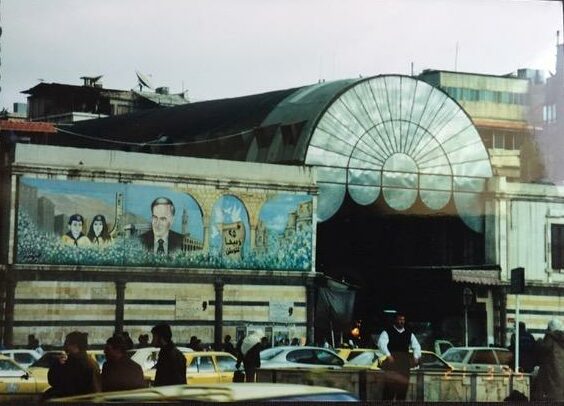
Syria-Damascus Entrance to Souk with Assad’s Picture on it
Our local guide and driver in Lebanon and Syria were two Syrian Christians. While they would not talk about politics, they would say: “We have freedom of religion in Syria.” The ruling Assad family are members of the Alewite sect of Shia Islam, and only 10% of Muslims are Alewites in Syria. It makes sense that the Assads would not try to impose their particular religion on their countrymen. That’s also why Iran, the home of Shia, has always supported the Assads in Syria, a mostly Sunni nation. It also explains why Christians and other religious minorities generally support the Assad government.
Before the civil war, there were millions of tourists in Syria. We toured the wonderful city of Damascus, with its ancient souks, old city, mosques, aged churches, and Roman ruins. Walt (the Armenian) spotted an ice cream shop:
“That’s called ‘stretchy’ ice cream. I remember it’s the best ice cream in the world.”
Fran replied, “I’ll try lots of local foods, but that doesn’t look safe to me.”
Walt: “It’s wonderful. Everyone should try one.”
Of course, everyone who had ice cream loved it. But everyone that ate it, including Walt, got sick to their stomach for a day-and-a-half. Visitors to developing countries should only eat well-cooked foods, sealed beverages, and fruit that they’ve peeled themselves, especially in the streets.
Other Damascus sights:
- St. Paul’s Chapel was where St. Paul was lowered over the city walls to escape the Romans.
- The Great Mosque of Damascus was started in 715 and is one of the oldest and largest mosques in the world.
- Maristan Nur ad-Din was built as a 12th century lunatic asylum. (I felt right at home there.) It served its purpose for 700 years, and is now, appropriately, a medical museum.
- The Azem Palace, built by the Ottoman Pasha, is suitably impressive.
The big souq (market) is 240 years old. Fran and I stopped at a shop that displayed some Jewish articles. The owners introduced themselves as “the last two Jews left in Damascus”. They showed us some really interesting artifacts. One was a leather piece of parchment from an old Torah. While we were skeptical whether the two men were really Jewish, and how old the article really was, we bought it. When we got back to the USA, we showed it to Fran’s cousin in Kansas City who has the largest private Judaica collection in this country. He not only authenticated it, he tried to buy it from us. We wound up donating it to Omaha’s Beth El Synagogue, where it was framed and hangs to this day. (We later read on the Internet that the two men really were the last two Jews in Damascus, but whether they are still there is questionable.)
Jan, our tour escort, gave us the choice of two interesting cities to visit: Palmyra, to the East, or Aleppo, to the North. The group chose Aleppo, and we’re glad they did, as Aleppo was mostly destroyed later during the Syrian civil war. Damascus and Aleppo were founded about 8000 years ago. They are reputedly the oldest continuously inhabited cities in the world. In the Aleppo Museum we saw the clay tablets using the ancient Ugaritic alphabet. They’re about 3500 years old, and were the first alphabet to use vowels as well as consonants. Eventually, this led to the Greek and Latin alphabets.
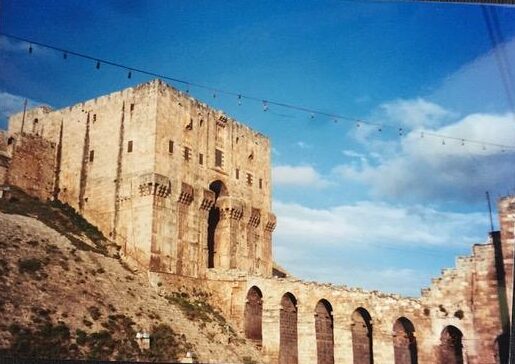
Syria-Aleppo Citadel
Aleppo was conquered and destroyed many times, but always rebuilt. Hopefully, it will be again. It had, when we visited, an old city with narrow alleys, covered souks, caravansaries (for caravans of yore), ancient churches and big mosques. The 7 mile long aquaduct was built by the Romans. The impressive Citadel was originally built 1000 years ago. The madrassa (Muslim school) dates from 1100. Tamerlane sacked both Aleppo and Damascus in 1400, massacred the inhabitants, but sent the artisans back to Samarkand, his capital (now in Uzbekistan).
The Syrian women were dissimilar. Some female faces were completely covered, some wore European clothing. The Kurdish women are emancipated and serve in their military. But family is very important to every person in Syria. So many families have now been separated, and so many family members have now been killed, I wonder whether Syrian culture can ever be the same as it was.
Epilogue
After Syria, we flew to the Mediterranean island of Cyprus. Its a beautiful place, with many historic and geographic sights. For us, the political division between the Republic of Cyprus and the Turkish Republic of Northern Cyprus was the most interesting. Given independence in 1960, the Republic of Cyprus is run by the Greek Cypriots on the island. Its a member of the European Union. But the northern third of the island is the quasi-independent nation of the Turkish Republic of Northern Cyprus. Its only recognized diplomatically by Turkey, and separated from the Republic of Cyprus by a United Nations strip. We went to the border but did not cross into Northern Cyprus. At least they’re not fighting.
Jordan has continued to be as stable as any country in the Middle East. Lebanon still is violently divided among cultures and religions. The governments are unstable. With Hezbollah controlling some of the government and some of the nation, there’s not much hope of Lebanon again becoming the “Switzerland of the Mideast”.
Syria is approaching a full decade of civil war. The active factions are the government of Bashar al-Assad, the Russians, ISIS, the Kurds, the Turks, and even a limited involvement of the USA. After destruction of much of the country, and millions of people killed or displaced, Bashar al-Assad with his allies seem to be gaining control. Hopefully, peace will come, the Syrian people will be able to go back to their homes, and even tourists will return.
Our travel leader, Jan, is still leading tours, but not to Syria or Lebanon. We stayed in touch with Walt and Lisa, and they told us about a trip they were taking with the Armenian American Assembly. Of course, it was to Armenia (and to another quasi-independent country called Nagorno-Karabakh). So we joined them. It was another fascinating journey, but that’s another saga.
